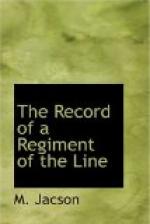Secoconi was at the time at war with a neighbouring tribe, and a fringe of hills only, divided the combatant parties, but an interval was called in their operations by mutual consent to allow of the passage of the British through their respective countries. On leaving behind the outposts of one, the outposts of the other were met with.
Having reached this point to the north of the Transvaal, General Kitchener’s column was in a position to turn south, and, in conjunction with other columns on his right and left hand, to sweep the bush veldt and mountains southward towards the railway, near which another force under the personal command of Sir Bindon Blood, who was in charge of the entire operations, was drawn up ready to intercept any Boers who might try to move across the railway from north to south.
At Vergelegen, where the column halted for the night of the 18th, some of Secoconi’s headmen came into camp for an interview. They were much impressed with what they saw, patted the 5-inch gun with friendly concern, and having relieved the General of his tobacco-pouch and a box of cigars, and offering their assistance when not busy with their neighbours, returned to their kraals.
The mounted troops were sent on ahead the same day to Pokwani town, where it was supposed the Boers had collected a quantity of cattle. No trace, however, of either Boers or cattle was found there.
The columns comprising the drive southward were in constant communication with each other by signalling. Plumer’s column was immediately on Kitchener’s right, holding the line of the Oliphant’s River, thus preventing the Boers, who were scattered in small groups in the bush veldt, from escaping in the direction of Pietersburg, whilst Park’s column was operating on Kitchener’s left, thus preventing the Boers breaking back towards Waterval and the Steenkampsberg mountains.
Gradually Kitchener’s column moved southward, driving the Boers off the high ground and picking them up with their cattle and families in the low or bush veldt. To do this with greater effect the column was divided, one portion consisting of the battalion, one gun, the I.L.H. and Australians under Colonel Davies proceeding in a north-westerly direction to stop the Boers breaking back into the bush veldt in rear, whilst General Kitchener with the remainder of the column marched over the high ground overlooking the bush veldt, and on the direct road to the south. On the 22nd Davies’ column reached Enkeldedoorn, whilst General Kitchener with the Rifle Brigade occupied Vaal Kop on the morning of the 23rd. On the first day out the mounted troops of Davies’ force, scouring the bush in their advance, captured 23 prisoners, 8 wagons, 450 head of cattle, and 4000 sheep. They also brought in a number of families, some of whom had been hiding for months in kloofs and dongas in great fear of the Kaffirs. One woman with her children was seen weeping by the side of the track, and on being asked the reason, she implored that she also might be taken into the railway and not left behind. She was comforted by an assurance that the column would return and that she would be taken in.




